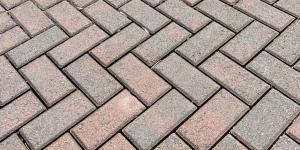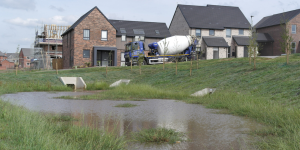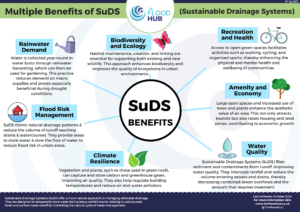This blog has been written by The Flood Hub People.
Sustainable Drainage Systems, or SuDS, are a smart, natural approach to managing surface water in urban areas. Rather than relying solely on traditional pipes and drains, SuDS use natural processes to slow, store and filter rainwater, helping to reduce flood risk while providing a host of additional environmental and community benefits.
As our towns and cities grow, and more land is covered with roads, pavements, and rooftops, the ground’s natural ability to absorb rainfall is reduced. Add in climate change, which brings more frequent and intense storms, and the need for effective surface water management has never been greater. SuDS are now playing a vital role in making our urban areas safer, greener and more resilient.
SuDS come in a variety of forms, each tailored to manage water in different ways while enhancing the environment.
Permeable paving is one of the most common techniques. It allows water to pass through the surface or the gaps between paving blocks, infiltrating into the ground below rather than running straight into drains. This helps reduce puddling, limits surface water flooding and can be designed in an aesthetically pleasing way to enhance the streetscape or a driveway.

Swales and detention basins are another key SuDS option. These are shallow, vegetated channels or depressions that temporarily store excess rainwater. During dry periods, they may contain no water at all, functioning as green spaces for the community. During heavy rainfall, they slow the flow of water, reduce peak river levels downstream, and provide habitat for plants and wildlife.

Ponds and wetlands offer some of the most significant environmental benefits. These vegetated areas can store large volumes of runoff, allowing sediment and pollutants to settle or be broken down naturally. Wetlands in particular provide rich habitats for wildlife, support biodiversity, and can even improve air quality. They also create attractive amenity spaces for residents, turning functional flood management into a community asset.

While all SuDS are designed to manage flood risk, their benefits extend far beyond water control.
Flood Risk Reduction
By slowing the movement of water through urban catchments and retaining it temporarily, SuDS reduce pressure on traditional drainage systems. This means fewer flash floods and lower flood peaks in rivers, helping to protect homes, businesses and infrastructure from extreme rainfall events.
Improved Water Quality
Surface water runoff can carry a surprising range of pollutants, from oils and metals deposited on roads to fertilizers and pesticides from agricultural areas. SuDS act as a natural filter, capturing sediment, breaking down pollutants and improving the quality of water that eventually enters rivers and streams. This supports healthier aquatic ecosystems and ensures safer waterways.
Biodiversity and Habitat Creation
Many SuDS measures, such as wetlands and green swales, create habitats for a variety of species. By increasing green infrastructure in urban areas, these systems help connect fragmented habitats, encouraging wildlife to thrive in otherwise built-up environments. For residents, this means more access to green, biodiverse spaces where they can relax and engage with nature.
Community and Social Benefits
SuDS don’t just benefit the environment, they also improve quality of life. Green spaces created through SuDS can be used for recreation, socialising and community events. They can also foster a sense of stewardship, with communities taking pride in well-managed and attractive landscapes.
Soil and Environmental Benefits
By retaining water and slowing runoff, SuDS help reduce soil erosion and maintain healthy soil structure. This, in turn, can support carbon storage and contribute to broader climate resilience goals. Vegetated SuDS areas can also reduce urban heat, improve air quality and enhance overall environmental health.
Sustainable Drainage Systems (SuDS) are more than just flood prevention tools. By retaining, slowing, and naturally filtering water, they reduce flood risk, improve water quality, create habitats, and provide green, functional spaces for communities. SuDS are a practical, environmentally friendly solution that help cities adapt to climate change, improve biodiversity, and enhance quality of life.
For more guidance and examples visit our dedicated SuDS page here.
Click here to download our Multiple Benefits of SuDS resource from The Flood Hub.
